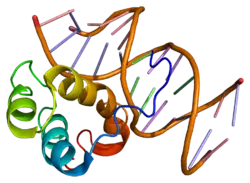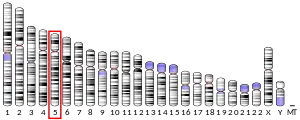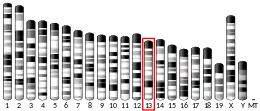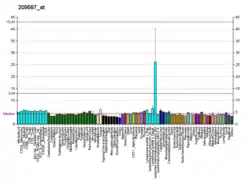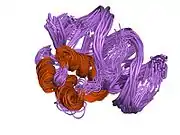Paired-like homeodomain 1 is a protein that in humans is encoded by the PITX1 gene.[5][6][7]
Function
This gene encodes a member of the RIEG/PITX homeobox family, which is in the bicoid class of homeodomain proteins. Members of this family are involved in organ development and left-right asymmetry. This protein acts as a transcriptional regulator involved in basal and hormone-regulated activity of prolactin.[7]
Clinical relevance
Mutations in this gene have been associated with autism,[8] club foot[9] and polydactyly[10] in humans.
Genetic basis of pathologies
Genomic rearrangements at the PITX1 locus are associated with Liebenberg syndrome.[11] In PITX1 Liebenberg is associated with a translocation or deletions, which cause insert promoter groups into the PITX1 locus.[11] A missense mutation within the PITX1 locus is associated with the development of autosomal dominant clubfoot.[9]
Interactions
PITX1 has been shown to interact with pituitary-specific positive transcription factor 1.[12]
References
- 1 2 3 GRCh38: Ensembl release 89: ENSG00000069011 - Ensembl, May 2017
- 1 2 3 GRCm38: Ensembl release 89: ENSMUSG00000021506 - Ensembl, May 2017
- ↑ "Human PubMed Reference:". National Center for Biotechnology Information, U.S. National Library of Medicine.
- ↑ "Mouse PubMed Reference:". National Center for Biotechnology Information, U.S. National Library of Medicine.
- ↑ Crawford MJ, Lanctôt C, Tremblay JJ, Jenkins N, Gilbert D, Copeland N, Beatty B, Drouin J (1997). "Human and murine PTX1/Ptx1 gene maps to the region for Treacher Collins syndrome". Mammalian Genome. 8 (11): 841–5. CiteSeerX 10.1.1.326.9619. doi:10.1007/s003359900589. PMID 9337397. S2CID 8557603.
- ↑ Shang J, Li X, Ring HZ, Clayton DA, Francke U (February 1997). "Backfoot, a novel homeobox gene, maps to human chromosome 5 (BFT) and mouse chromosome 13 (Bft)". Genomics. 40 (1): 108–13. doi:10.1006/geno.1996.4558. PMID 9070926.
- 1 2 "Entrez Gene: PITX1 paired-like homeodomain transcription factor 1".
- ↑ Philippi A, Tores F, Carayol J, Rousseau F, Letexier M, Roschmann E, et al. (December 2007). "Association of autism with polymorphisms in the paired-like homeodomain transcription factor 1 (PITX1) on chromosome 5q31: a candidate gene analysis". BMC Medical Genetics. 8: 74. doi:10.1186/1471-2350-8-74. PMC 2222245. PMID 18053270.
- 1 2 Alvarado DM, McCall K, Aferol H, Silva MJ, Garbow JR, Spees WM, et al. (October 2011). "Pitx1 haploinsufficiency causes clubfoot in humans and a clubfoot-like phenotype in mice". Human Molecular Genetics. 20 (20): 3943–52. doi:10.1093/hmg/ddr313. PMC 3177645. PMID 21775501.
- ↑ Klopocki E, Kähler C, Foulds N, Shah H, Joseph B, Vogel H, et al. (June 2012). "Deletions in PITX1 cause a spectrum of lower-limb malformations including mirror-image polydactyly". European Journal of Human Genetics. 20 (6): 705–8. doi:10.1038/ejhg.2011.264. PMC 3355260. PMID 22258522.
- 1 2 Spielmann M, Brancati F, Krawitz PM, Robinson PN, Ibrahim DM, Franke M, et al. (October 2012). "Homeotic arm-to-leg transformation associated with genomic rearrangements at the PITX1 locus". American Journal of Human Genetics. 91 (4): 629–35. doi:10.1016/j.ajhg.2012.08.014. PMC 3484647. PMID 23022097.
- ↑ Szeto DP, Ryan AK, O'Connell SM, Rosenfeld MG (July 1996). "P-OTX: a PIT-1-interacting homeodomain factor expressed during anterior pituitary gland development". Proceedings of the National Academy of Sciences of the United States of America. 93 (15): 7706–10. Bibcode:1996PNAS...93.7706S. doi:10.1073/pnas.93.15.7706. PMC 38811. PMID 8755540.
Further reading
- Shang J, Luo Y, Clayton DA (June 1997). "Backfoot is a novel homeobox gene expressed in the mesenchyme of developing hind limb". Developmental Dynamics. 209 (2): 242–53. doi:10.1002/(SICI)1097-0177(199706)209:2<242::AID-AJA10>3.0.CO;2-0. PMID 9186059. S2CID 46565338.
- Poulin G, Turgeon B, Drouin J (November 1997). "NeuroD1/beta2 contributes to cell-specific transcription of the proopiomelanocortin gene". Molecular and Cellular Biology. 17 (11): 6673–82. doi:10.1128/mcb.17.11.6673. PMC 232521. PMID 9343431.
- Tremblay JJ, Drouin J (April 1999). "Egr-1 is a downstream effector of GnRH and synergizes by direct interaction with Ptx1 and SF-1 to enhance luteinizing hormone beta gene transcription". Molecular and Cellular Biology. 19 (4): 2567–76. doi:10.1128/mcb.19.4.2567. PMC 84049. PMID 10082522.
- Tremblay JJ, Marcil A, Gauthier Y, Drouin J (June 1999). "Ptx1 regulates SF-1 activity by an interaction that mimics the role of the ligand-binding domain". The EMBO Journal. 18 (12): 3431–41. doi:10.1093/emboj/18.12.3431. PMC 1171422. PMID 10369682.
- Pellegrini-Bouiller I, Manrique C, Gunz G, Grino M, Zamora AJ, Figarella-Branger D, Grisoli F, Jaquet P, Enjalbert A (June 1999). "Expression of the members of the Ptx family of transcription factors in human pituitary adenomas". The Journal of Clinical Endocrinology and Metabolism. 84 (6): 2212–20. doi:10.1210/jcem.84.6.5760. PMID 10372733.
- Tahara S, Kurotani R, Sanno N, Takumi I, Yoshimura S, Osamura RY, Teramoto A (October 2000). "Expression of pituitary homeo box 1 (Ptx1) in human non-neoplastic pituitaries and pituitary adenomas". Modern Pathology. 13 (10): 1097–108. doi:10.1038/modpathol.3880204. PMID 11048804.
- Quentien MH, Manfroid I, Moncet D, Gunz G, Muller M, Grino M, Enjalbert A, Pellegrini I (November 2002). "Pitx factors are involved in basal and hormone-regulated activity of the human prolactin promoter". The Journal of Biological Chemistry. 277 (46): 44408–16. doi:10.1074/jbc.M207824200. PMID 12223489.
- Ghosh AK, Majumder M, Steele R, Ray R, Ray RB (February 2003). "Modulation of interferon expression by hepatitis C virus NS5A protein and human homeodomain protein PTX1". Virology. 306 (1): 51–9. doi:10.1016/S0042-6822(02)00029-6. PMID 12620797.
- Hiroi N, Kino T, Bassett M, Rainey WE, Phung M, Abu-Asab M, Fojo T, Briata P, Chrousos GP, Bornstein SR (May 2003). "Pituitary homeobox factor 1, a novel transcription factor in the adrenal regulating steroid 11beta-hydroxylase". Hormone and Metabolic Research. 35 (5): 273–8. doi:10.1055/s-2003-41301. PMID 12915995. S2CID 260168691.
- Kolfschoten IG, van Leeuwen B, Berns K, Mullenders J, Beijersbergen RL, Bernards R, Voorhoeve PM, Agami R (June 2005). "A genetic screen identifies PITX1 as a suppressor of RAS activity and tumorigenicity". Cell. 121 (6): 849–58. doi:10.1016/j.cell.2005.04.017. hdl:1874/17813. PMID 15960973. S2CID 18065721.
- Lord RV, Brabender J, Wickramasinghe K, DeMeester SR, Holscher A, Schneider PM, Danenberg PV, DeMeester TR (November 2005). "Increased CDX2 and decreased PITX1 homeobox gene expression in Barrett's esophagus and Barrett's-associated adenocarcinoma". Surgery. 138 (5): 924–31. doi:10.1016/j.surg.2005.05.007. PMID 16291394.
- Olsen JV, Blagoev B, Gnad F, Macek B, Kumar C, Mortensen P, Mann M (November 2006). "Global, in vivo, and site-specific phosphorylation dynamics in signaling networks". Cell. 127 (3): 635–48. doi:10.1016/j.cell.2006.09.026. PMID 17081983. S2CID 7827573.
- Picard C, Azeddine B, Moldovan F, Martel-Pelletier J, Moreau A (September 2007). "New emerging role of pitx1 transcription factor in osteoarthritis pathogenesis". Clinical Orthopaedics and Related Research. 462: 59–66. doi:10.1097/BLO.0b013e3180d09d9c. PMID 17549029. S2CID 8232057.
- Qi DL, Ohhira T, Fujisaki C, Inoue T, Ohta T, Osaki M, Ohshiro E, Seko T, Aoki S, Oshimura M, Kugoh H (April 2011). "Identification of PITX1 as a TERT suppressor gene located on human chromosome 5". Molecular and Cellular Biology. 31 (8): 1624–36. doi:10.1128/MCB.00470-10. PMC 3126332. PMID 21300782.
External links
- PITX1+protein,+human at the U.S. National Library of Medicine Medical Subject Headings (MeSH)
- http://omim.org/entry/602149 at OMIM, holds the most up to date information on PITX1.
- https://ghr.nlm.nih.gov/gene/PITX1 at the NIH, has a summary on the effects of PITX1 mutations.
This article incorporates text from the United States National Library of Medicine, which is in the public domain.
